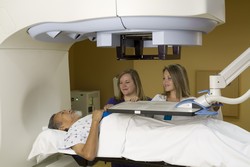Secondary neoplasms and radiation therapy
Neutrons are an unwanted by-product in radiotherapy. They are generated also in the upper atmosphere by cosmic rays, contributing to radiation at high altitudes and exposure during long-haul air travel. The ability to quantify the risks from exposure to neutrons has important implications for radiation protection. The precise harmful effects on humans are incompletely understood but clinicians believe that they instigate different ionisation clusters within cells contributing to various damage processes. The EU-funded ANDANTE(opens in new window) (Multidisciplinary evaluation of the cancer risk from neutrons relative to photons using stem cells and the induction of second malignant neoplasms following paediatric radiation therapy) project investigated the biological association of neutron exposure with carcinogenesis. As a first step, researchers performed Monte Carlo simulations and measurements to characterise the neutron beams that were used in radiobiological experiments. The characteristics of secondary particles generated by neutrons were used to simulate the initial damage to DNA molecules. Scientists identified the neutron energy required to cause DNA damage, which was in general agreement with the conventional radiation protection weighting factors. Thyroid, salivary, and mammary gland stem cells were exposed to different doses of neutron beams and exhibited a clear dose-response relationship for clonogenic survival. However, no effect on carcinogenesis-related markers was seen, and upon implantation of irradiated stem cells into mice, no tumours developed. The consortium generated a method for neutron dose calculation and combined it with the relative biological effectiveness values of neutron energy to estimate the risk of secondary cancer onset. In particular, in a prospective epidemiological study they compared second cancer rates following paediatric proton therapy in comparison with conventional radiotherapy. Their calculations indicated that it may require several decades of epidemiological follow-up time to demonstrate any carcinogenic effect of proton therapy. Nonetheless, the setting up of an international registry of childhood cancers has the potential to give insight into the link between radiation exposure and the subsequent risk of second cancers linked to such treatments.







